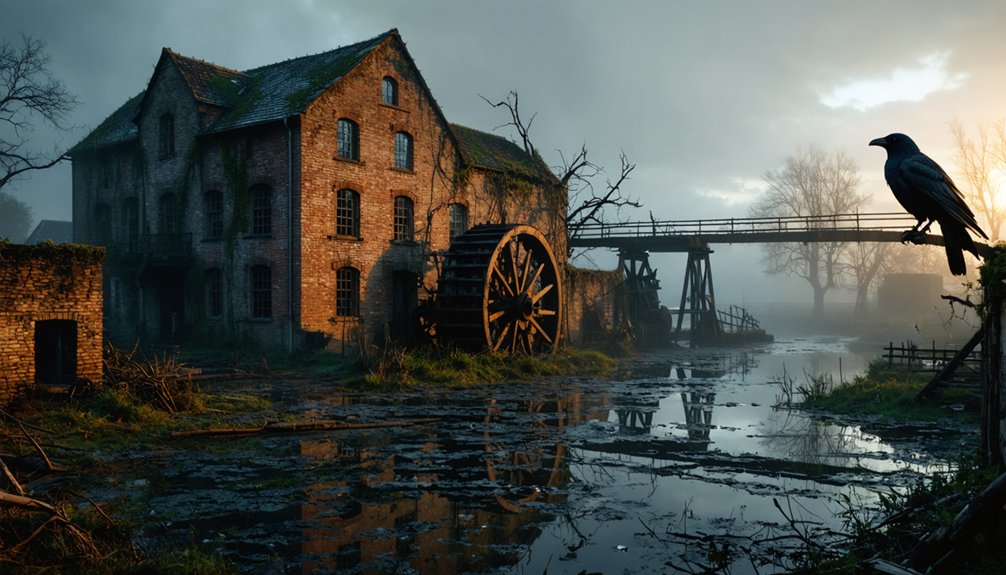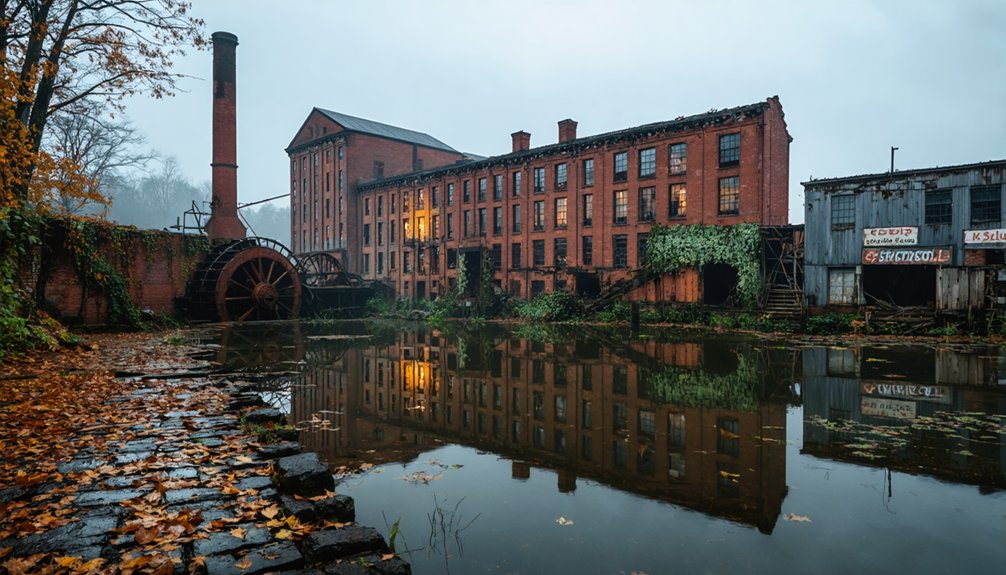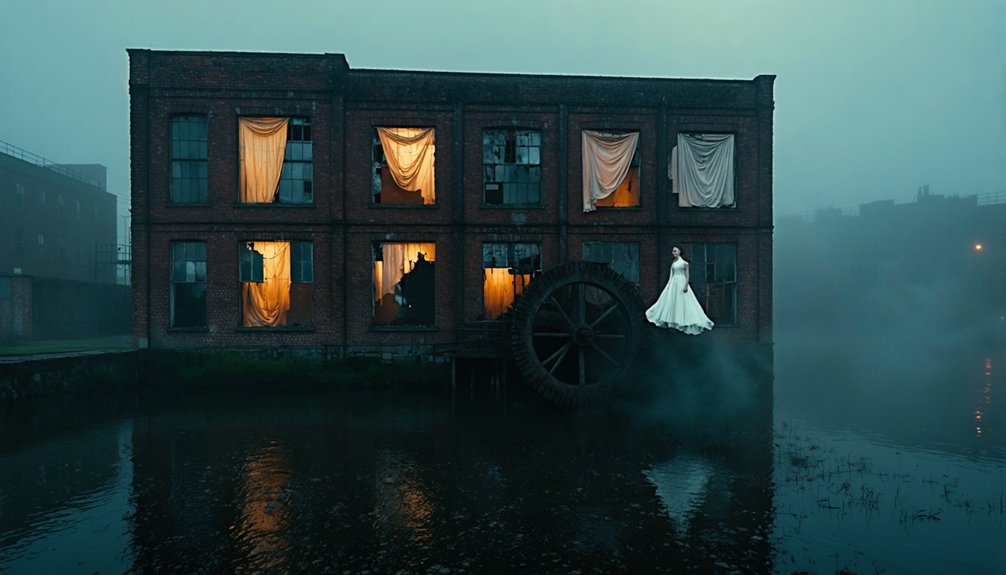When visiting haunted mill towns, time your exploration during dawn, dusk, or historical anniversaries for heightened experiences. Bring multiple recording devices to capture potential electronic voice phenomena while documenting sensations methodically. Connect with local historians and residents to understand authentic folklore and contextual significance. Wear appropriate footwear and protective gear while respecting physical boundaries and cultural sensitivities. Watch for consistent paranormal indicators like sudden temperature shifts, unexplained sounds, and visual anomalies. These preparations lay the groundwork for truly meaningful encounters.
Key Takeaways
- Visit during dawn or dusk when paranormal activity tends to peak and align with historical mill shift changes.
- Bring recording equipment like infrared cameras and digital recorders to document potential EVPs and unexplained phenomena.
- Research the town’s industrial history and consult local historians to understand the context behind reported hauntings.
- Prioritize safety with proper footwear, small group sizes, and knowledge of emergency exits in potentially unstable structures.
- Note environmental changes like sudden cold spots, unexplained sounds, or visual anomalies as potential signs of paranormal activity.
Plan Your Visit During Historical Transition Times
Ghosts of industry past linger most palpably during changing moments in abandoned mill towns. To maximize your experience, align your visit with key historical timelines—dawn and dusk particularly capture the essence of shift changes when mills bustled with workers.
These shifting hours often heighten both atmospheric conditions and reported paranormal encounters.
Consider seasonal changes that mirror original operational patterns; many lumber mills ran primarily during winter when rivers froze and logs could be transported more easily.
Spring thaws and autumn’s early darkness marked vital turning periods in mill town life. Colorado’s mining communities experienced significant abandonment when mines were depleted, transforming bustling settlements into the ghost towns we explore today.
Research local anniversaries of significant events—mill openings, closures, major fires, or economic collapses—when commemorative tours might offer deeper insights.
These temporal windows connect you more authentically to the economic and technological changes that shaped these now-silent communities.
Remember to bring proper citation materials to document any historical or paranormal findings for your haunted history project.
Document Experiences With Purpose and Precision
When you venture into the atmospheric remains of abandoned mill towns, methodical documentation becomes your bridge between fleeting paranormal encounters and credible evidence.
Prepare multiple recording devices—infrared cameras for visual anomalies and digital recorders for EVPs—positioning them strategically in activity hotspots.
Equipment redundancy is non-negotiable—deploy varied recording tools in locations where history suggests paranormal activity manifests.
Take meticulous field notes documenting exact times, locations, and environmental conditions alongside your subjective experiences.
Don’t rely on memory; record sensations, temperature shifts, and unusual sounds as they occur. Use shorthand codes for efficiency without sacrificing detail.
After your investigation, organize your data collection chronologically and by location, cross-referencing environmental readings with audio/visual captures.
Create redundant backups of all files, carefully labeling with metadata.
This systematic approach transforms isolated experiences into analyzable patterns that may validate the historical hauntings you’re seeking.
Always conduct a thorough post-investigation review to carefully analyze your recordings for evidence that may have been missed during the initial visit.
Hunting with partners rather than alone not only provides additional witnesses to phenomena but also ensures team safety when navigating potentially hazardous abandoned structures.
Engage Respectfully With Local Histories and Legends
Beneath the weathered facades and rusted machinery of abandoned mill towns lies more than just physical history—a rich tapestry of human experience that demands your reverence and careful handling.
Before visiting, research the town’s industrial past and demographic shifts to contextualize any hauntings you might encounter.
When exploring local folklore, consult historical societies and long-time residents rather than relying on commercialized accounts. These community narratives often reflect collective memory about industrial accidents, labor struggles, and cultural shifts.
Honor different perspectives—some see ghosts as literal presences, others as metaphorical expressions of unresolved history.
Avoid exploiting recent tragedies or sacred cultural elements. Instead, approach each story as a window into how communities process hardship, preserve identity, and maintain connections to their industrial heritage. Remember that many historic sites like LeHunt enforced stark inequality, with segregated housing and dramatically different living conditions for workers based on race and nationality.
In Lake Mills, legends like Rocky the Lake Monster capture the imagination of both locals and visitors, with the creature’s story being honored through themed beverages at local establishments.
Protect Yourself From Both Physical and Metaphysical Hazards
Exploring abandoned industrial complexes presents dual layers of risk that require vigilant preparation and awareness. Always prioritize physical safety by wearing closed-toe, non-slip footwear on uneven surfaces and following posted rules. Avoid bringing food, open flames, or prohibited items that compromise everyone’s security and heighten fire hazards in these often-dilapidated structures. Researching the theme and intensity level of the haunted mill town beforehand will help you understand what to expect during your visit.
Equally important is metaphysical preparation when visiting locations charged with historical energy. Research the mill town’s past before arriving, maintain small group sizes of four or fewer, and bring personal protective talismans if they provide psychological comfort. Familiarize yourself with emergency exit locations should you need to leave quickly.
Should overwhelming sensations occur, don’t hesitate to exit immediately. Remember that uncrowded pathways not only guarantee physical escape routes but can also provide metaphysical breathing room when confronting the charged atmosphere of industrial ruins.
Recognize Signs of Authentic Paranormal Activity
Despite common misconceptions about paranormal phenomena, authentic ghostly manifestations typically follow distinct patterns that seasoned investigators can recognize.
When exploring mill towns, pay attention to visual indicators like apparitions following repetitive paths, unexplained footprints, or mysterious stains that resist cleaning. These often occur in locations with documented tragedies.
Auditory phenomena provide compelling evidence—listen for disembodied footsteps, whispers, or phantom music, particularly in buildings with violent histories.
Environmental changes, like sudden cold spots or unexplained humidity, frequently accompany genuine hauntings. The presence of water sources nearby may significantly increase paranormal activity as water acts as a conductor of energy.
Record your experiences to identify patterns; authentic paranormal activity often occurs at consistent times or during specific weather conditions.
The most credible manifestations are those reported similarly by multiple witnesses over years, especially when they align with historical records of tragedy or untimely death.
Consider conducting EVP recordings during your investigation, as capturing electronic voice phenomena represents one of the most valuable forms of evidence in paranormal research.
Frequently Asked Questions
Can Children Safely Visit Haunted Mill Towns?
Yes, children can visit with proper supervision, age-appropriate attractions, and attention to child safety. Look for family friendly experiences during daylight hours to minimize risks while maintaining educational value.
How Do Spirits Typically Manifest in Mill Town Settings?
In mill towns, you’ll encounter spirits as apparitions of workers, emotional sounds like sobbing, shadow figures, and electromagnetic disturbances—all manifestations tied to the area’s industrial history and tragic ghostly encounters.
What Triggers Paranormal Activity in Abandoned Industrial Spaces?
Industrial decay triggers paranormal activity when you’re exploring spaces with historical significance. Environmental factors, structural anomalies, psychological expectations, and traumatic past events all converge to manifest what you’ll perceive as supernatural phenomena.
Are Certain Seasons Better for Encountering Mill Town Apparitions?
You’ll encounter more mill apparitions during autumn when fall festivals and ghost tours abound. October’s cooler temperatures, shorter days, and atmospheric conditions create ideal conditions for manifestations, though winter’s quieter atmosphere offers unique investigative advantages.
Should I Inform Spirits of My Presence When Investigating?
Yes, you should always announce yourself to spirits. This respectful approach establishes clear boundaries for spirit communication and acknowledges their presence, which may increase your chances of meaningful paranormal interactions during your investigation.
References
- https://nightofthejack.com/2025/01/23/top-creepy-ghost-towns-in-america/
- https://www.youtube.com/watch?v=Ev2OZy3bNAc
- https://www.mythfolks.com/haunted-us-ghost-towns
- https://archive.org/stream/CreepyStories/EncyclopediaOfHauntedPlaces-GhostlyLocalesFromAroundTheWorld_djvu.txt
- https://www.wideopencountry.com/the-10-eeriest-ghost-towns-in-america/
- https://www.americanhauntingsink.com/whattodo
- https://albiongould.com/ghost-towns-to-visit-in-the-states/
- https://en.wikipedia.org/wiki/Ghost_hunting
- https://whakestudios.com/us-ghost-towns/
- https://en.wikipedia.org/wiki/List_of_reportedly_haunted_locations_in_the_United_States



